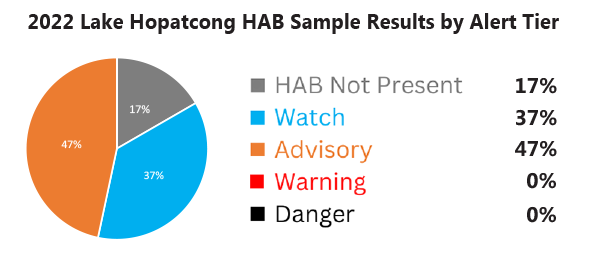
February 02, 2023| Environment
By: Donna Macalle Holly
A freshwater Harmful Algal Bloom, or HAB, is the excessive growth of cyanobacteria, also sometimes called blue-green algae, which can produce potentially harmful toxins (cyanotoxins). These cyanobacteria naturally occur in fresh water and can proliferate, or bloom, with the right combination of sunlight, still waters, and excess nutrients, like phosphorus. These blooms are usually a bright green, but can also appear as spilled paint, “pea soup,” or as having a thick coating or “mat” on the surface. Exposure to cyanobacteria can cause a range of health effects in people and pets.
On Lake Hopatcong, HAB monitoring is conducted by Princeton Hydro, volunteers, and the NJ Department of Environmental Protection (NJ DEP).
Along with its annual water quality monitoring, Princeton Hydro has also conducted cyanotoxin monitoring at multiple sites around the lake twice a summer since 2018. Those monitoring results are submitted to the Lake Hopatcong Commission and are available to view HERE.
For those who are interested, Princeton Hydro's Dr. Fred Lubnow will be presenting a review of the 2022 water quality report on Thursday, February 16, from 7 - 8 pm over Zoom. All are welcome, registration is required.
Since 2021, the Lake Hopatcong Foundation has coordinated volunteer HAB monitoring on Lake Hopatcong. The monitoring is part of a larger HAB monitoring and reporting project in the Musconetcong River Watershed led by the Musconetcong Watershed Association (MWA).
Three dedicated volunteers monitored 16 sites on the lake from July through September 2022. The data collected was submitted to the MWA, and, when readings dictated, volunteers also reported potential HABs to NJ DEP for additional testing.
The results of the volunteer HAB monitoring for 2022 were presented by the MWA at the Musconetcong River Management Council. A video of the presentation can be viewed HERE.
In addition to using enhanced technology such as flight surveillance and continuous monitoring meters, NJ DEP also conducts routine monitoring and investigates suspected HABs from reports submitted by the public. More information about NJ DEP's HAB monitoring can be found HERE.
NJ DEP has developed a color-coded alert index (WATCH, ADVISORY, WARNING, and DANGER), which provides recommendations of recreational activities that should not be pursued based on levels of cyanobacteria and/or cyanotoxins levels.
According to NJ DEP's HAB Interactive Mapping and Communication System, of the 30 samples tested on Lake Hopatcong in 2022, 5 showed no HAB present, 11 tested at the WATCH level, and 14 tested at the ADVISORY level. None of the samples tested at the WARNING or DANGER levels.

If you suspect a HAB on Lake Hopatcong, you should avoid it and report it. NJ DEP has a suspected HAB report form, which will take you through all of the information needed in order to determine the appropriate response actions.
You can do your part to prevent HABs and improve the water quality on Lake Hopatcong. Below are a few ways you can help.
For more helpful tips on simple steps you can take to help protect Lake Hopatcong, check out our Lake Hopatcong Lake-Friendly Living Guide.